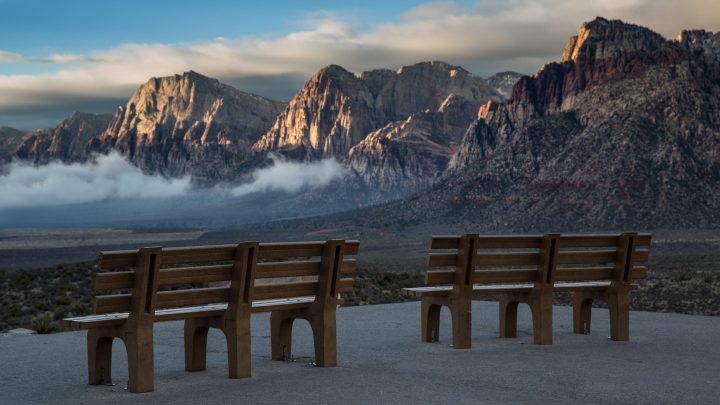
Can cloud seeding save a drought-stricken “national treasure”?
Can cloud seeding save a drought-stricken “national treasure”?

About 15 miles southwest of Las Vegas, Nevada, I’m bouncing up a rutted gravel road in the foothills of the Spring Mountains with Pauline Van Betten, a local real estate agent and environmental advocate.
“Go slow,” Van Betten said. “I do a lot of land that’s off-road and I’ve had two popped tires.”
Van Betten is a land and water specialist with Save Red Rock, nonprofit group with a mission to preserve and protect Red Rock Canyon, a national conservation area north of here, known for its sandstone cliffs and scenic hiking trails. It’s June, and after a wet winter and spring, the rocky ground is dotted with purple and yellow wildflowers.
“We had record rains,” she said. “Everything looks a lot greener because of it.”
Those record rains got a boost from technology. Van Betten was taking me to see a device called a cloud seeding generator. We parked next to a hillside and hiked up to find a big metal box, painted camouflage green, with what looked like an empty oil drum mounted atop a tower.
In the winter, Van Betten said, scientists remotely monitor the weather here. When a storm moves in, they can fire up the generator, which releases silver iodide into the passing clouds. The microscopic particles provide a base for ice crystals to form at warmer temperatures than they otherwise would. Those crystals eventually fall out, as extra precipitation.
Van Betten is the reason this machine is here. A few years ago she was selling some land in the mountains north of here after the owner died.
“When I went to the property, I saw this great big box on it,” she said.
She traced the box to the Desert Research Institute, a Nevada-based organization that’s been involved in cloud seeding since the early 1960s.
“When they told me it was a cloud seeder I was like, ‘That’s my dream come true,’” she recalled. “‘A cloud seeder, we need that.’”
The Southwest was more than 20 years into a megadrought and Red Rock Canyon was suffering.
“All the Joshua trees were dying,” she said. “You’re just looking at this national treasure and you’re wondering what’s going to happen when all the trees are dead?”
So Save Red Rock raised more than $100,000 to bring in a cloud seeder to target the conservation area.
Frank McDonough leads the Desert Research Institute’s cloud seeding program. Last year he estimated cloud seeding increased precipitation in the Red Rock Canyon area by more than two billion gallons, or 14%.

McDonough said he often hears two concerns about the technology. First, that making it rain in one place could mean it doesn’t rain somewhere else. But he said, “if you didn’t cloud seed, the clouds are just going to cross the area and nothing’s going to come out, and then they’re going to evaporate as they move downwind of the mountain range.”
The other concern is whether the silver iodide can be harmful to the environment, especially with repeated use in a particular area.
“Everything we’ve looked at historically, the answer is no,” he said.
Silver iodide is insoluble, McDonough said, meaning it stays as a solid even in water.
“It doesn’t become something that plants slurp up,” he said. “If an animal’s happened to eat a dust particle of silver iodide, it’s just going to move right through them and [they will] poop it out.”
Others question the effectiveness of cloud seeding. Studies are mixed. An analysis by the World Meteorological Organization found a possible increase in precipitation from “essentially zero to more than 20%.” Others worry about unintended consequences, like the potential for flooding.
But as climate change brings more frequent and severe droughts, the practice is growing throughout the west. Last summer, the Nevada legislature approved $1.2 million for the Desert Research Institute’s cloud seeding programs. Millions of dollars in federal funding is supporting cloud seeding throughout the drought-stricken Colorado River Basin.
About 40 miles to our east is Lake Mead, the reservoir that provides most of Las Vegas’s drinking water and fell to a record low in 2022.
Cloud seeding won’t reverse climate change, or refill Lake Mead, Van Betten said. But it might make a difference for Red Rock Canyon.
“A lot of times, we’ll have people push back and say ‘just leave mother nature alone,’ but we’re past that,” said Van Betten. “We didn’t leave mother nature alone, so now if we have something that can assist, I feel like we have to.”
Additional reporting by Caitlin Esch.
There’s a lot happening in the world. Through it all, Marketplace is here for you.
You rely on Marketplace to break down the world’s events and tell you how it affects you in a fact-based, approachable way. We rely on your financial support to keep making that possible.
Your donation today powers the independent journalism that you rely on. For just $5/month, you can help sustain Marketplace so we can keep reporting on the things that matter to you.











